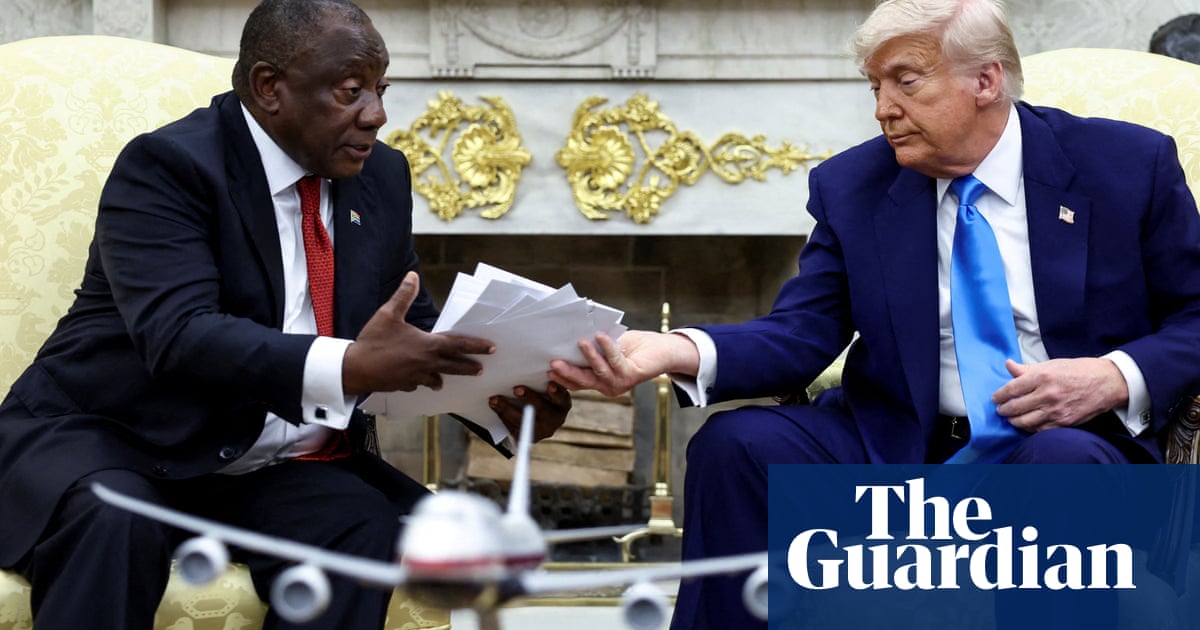We knew he was a bore and boor. Now we have learned thatDonald Trumpis an honorary Boer.
When he turned his attention toSouth Africaon Wednesday, it may come as no surprise that the US president – who has been sued for discriminating against Black apartment seekers, called for the death penalty for the Central Park Five, pushed the false claim that Barack Obama was born in Kenya, referred to Haiti and African nations as “shithole countries”, and blamed an air crash on DEI – was rooting for the whites.
Trump hadlaid a trap for South African president Cyril Ramaphosain his gold and gaudy Oval Office. After 20 minutes of a relative pleasantries, Trump’s delusion that a white genocide is happening in South Africa inevitably reared its ugly head.
Ramaphosa said “listening to the stories” of South Africans would help his counterpart better understand. But then, with his audience captive, Trump turned sinister and ordered his staff to dim the lights and activate a big screen. He was like a Bond villain startling guests with noxious gas or a doomsday machine.
Natalie Harp, a White House aide known as the “human printer” because she prints out favourable newspaper cuttings for Trump’s attention, swung into action. She plugged a laptop in the TV and played a video that showed South African opposition politicians Jacob Zuma and Julius Malema singing apartheid-era songs about shooting Boers, a term that refers to farmers or Afrikaners.
Then came drone footage purportedly showing Afrikaner graves marked by white crosses. And then Trump branded a sheaf of newspaper cuttings about recent killings in South Africa, muttering bleakly: “Death, death, death, horrible death.” Between the two men loomed a bust of Winston Churchill, who covered the Boer war as a reporter and was held as a prisoner in Pretoria.
Poor Ramaphosa had to sit and take it as the terrible truth dawned: he had been Zelenskyy’d. The last time Trump pulledan ambush like this, his weapon was the vice-president, JD Vance, bullying and berating Volodymyr Zelenskyy of Ukraine.
This time Vance was content to remain silent, wearing an absurdly long red tie and glowering with menace like an attack dog straining at the leash. Joining him on the sofa were defence secretary Pete Hegseth, looking gormless, and commerce secretary Howard Lutnick, looking smug. Behind them stood South African-born billionaire Elon Musk, brimming variously with boredom and contempt.
But Ramaphosa had learned lessons from Trump’s attempt to turn diplomacy into a reality TV series. France’s Emmanuel Macron, Britain’s Keir Starmer and Canada’s Mark Carney have all run the gauntlet of the TV cameras in the Oval Office, expertly serving up a sycophancy sandwich that combines craven flattery with a bit of gristle in the middle – a willingness to stick up for their own country.
Moreover, Ramaphosa knows Trump’s type and was not going to be intimated by white supremacy. He was born to a police sergeant and a domestic worker and grew up under the violent regime of racial apartheid. He was arrested after leading a student protest at college and served 11 months in solitary confinement. He founded a national mineworkers’ union and became an acolyte of Nelson Mandela in the liberation struggle.
He flattered by Trump by calling South Africa’s economy “tiny” compared to America’s, but who is the bigger man?
It must have been hard for Ramaphosa to take when Trump, droning on about the persecution of white farmers, asserted: “Now I will say, apartheid: terrible. That was the biggest threat. That was reported all the time. This is sort of the opposite of apartheid.”
But Ramaphosa had prepared a soft ambush of his own.Starmer might have brought an invitation to meet the king, but Ramaphosa knew that Trump loves nothing more than golf, so he brought the gift of a big book about South African golf courses. More importantly, he had a white cavalry including agriculture minister John Steenhuisen andgolfers Ernie Els and Retief Goosen.
There was also South African’s richest man, luxury goods magnate Johann Rupert, both whitesplaining and wealthsplaining – the two languages that Trump understands.
“We have many deaths, but it’s across the board – not just white farmers,” Rupert said, saying the country needs technological help from Musk’s Starlink, and even recalling how much his wife loved JD Vance’s book Hillbilly Elegy.
Trump had failed to hector Ramaphosa into submission and, like a bully lashing out, took out his frustration on NBC reporter Peter Alexander, whom he branded a “jerk” for asking abouthis plan to accepta $400m plane from Qatar.
“Why did a country give an airplane to the United States air force?” Trump asked rhetorically. “So they could help us out, because we need an Air Force One. That’s what that idiot talks about, after viewing a thing where thousands of people are dead.”
Ramaphosa interjected: “I’m sorry I don’t have a plane to give you.”
Trump, with a model plane on the table before him, responded: “I wish you did. I would take it. If your country offered the United States air force a plane, I would take it.”
“OK,” Ramaphosa replied, trying to keep a straight face.
Like Macron, Starmer and Carney before him, he had survived Washington’s trial by television.
